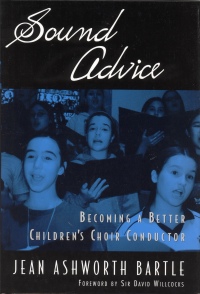| ________________
CM . . .
. Volume X Number 20 . . . . June 4, 2004
excerpt:
The above excerpt offers a glimpse into the way Jean Ashworth Bartle addresses pressing questions of today’s conductors by crafting a text overflowing with sound advice on a comprehensive range of relevant topics that can be immediately applied to the planning, implementation, and administration of children’s choir programs in school and community contexts. The audience for this book is far-reaching: beginning or seasoned choral music teachers, music teacher candidates, artistic directors of children’s community choirs, directors of children’s choirs in places of worship, as well as others involved in choral music for children (e.g., composers, parents, volunteers, administrators, board members). A major contribution to the field of choral music methods, the book is effectively organized in 12 chapters and includes a bibliography of related resources and detailed index. Readers will find the 13 appendices indispensable resources that make central concepts in the main body of the book more explicit. Chapters 1-5 focus on key ideas for guiding curriculum and instruction in choral music programs which are drawn from the extensive experiences of an internationally renown teacher and choral musician. Special techniques and principles for nurturing the singing skills of young children are followed by those for older children. The basic tenets of singing are covered: exquisite tone, effective breath support, clear diction, musical phrasing, and perfect intonation. Guidelines for planning focused, educative rehearsals that will prepare choirs for high levels of performance are discussed. A positive approach to disciplining and managing choristers’ behavior is advocated along with ways to create a “community of singers” and learning environment that is safe and non-threatening. The development of music literacy is emphasized and illustrated through a process-oriented teaching model that targets sight-reading skills and basic theory. Recommended repertoire representative of a wide variety of musical styles is analyzed, categorized and listed by ability level for both unison and part-singing. Extremely useful are the curriculum frameworks provided, as well as the identification of common choral teaching problems and suggested solutions. Valuable for readers are the organization and administration of choral music programs which is targeted in chapters 6-8. Issues related to personal time management, routines, communication with parents, seating plans, record keeping, rehearsal agendas, schedules and calendars, concert season plans, long range strategic plans, and collaboration with management are presented with concrete examples drawn from personal practice. The importance of really knowing children’s voices and discovering children’s singing potential is addressed through outlining a unique approach to the audition process. There is also a deliberate effort here to deal with ideas that are not normally included in university programs that aim to prepare choral teacher-conductors for their work in the field such as: making your school choir a vital part of school life, personal health and wellness, grooming for the podium, or serving as the artistic director of a community children’s choir. Conductors of more advanced, auditioned children’s choirs will find the final chapters of this book very intriguing as they reveal much about making their work more public, setting standards of excellence, and achieving higher levels of artistry. Conducting an orchestra and preparing children to sing a major work with an orchestra are both thoroughly discussed. For each of six major works, background information, text and translations, instructional ideas for teaching parts and overcoming barriers, as well as discographies are given to inspire and support conductors. Recording sessions, commissioning new choral works, and touring with children’s choirs are three other critical dimensions of community children’s choir programs that are outlined. Closure to the book is accomplished through the “voices” of children who attest that singing in a choir has had a profound impact on their hearts, minds, and spirits. Highly Recommended. Dr. Francine Morin is a professor of K-8 music education in the Faculty of Education, University of Manitoba.
To comment
on this title or this review, send mail to cm@umanitoba.ca.
Copyright © the Manitoba Library Association. Reproduction for personal
use is permitted only if this copyright notice is maintained. Any
other reproduction is prohibited without permission.
NEXT REVIEW |
TABLE OF CONTENTS FOR THIS ISSUE
- June 4, 2004.
AUTHORS |
TITLES |
MEDIA REVIEWS |
PROFILES |
BACK ISSUES |
SEARCH |
CMARCHIVE |
HOME |
